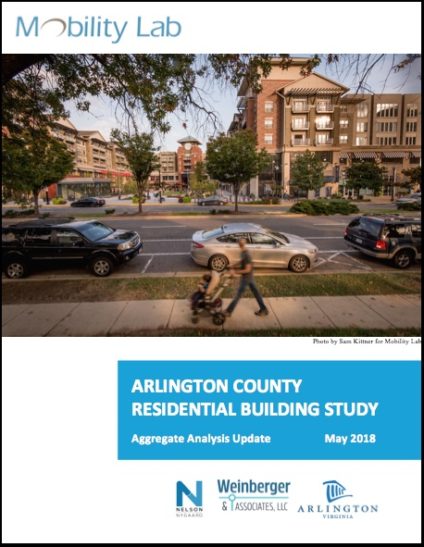
Separating the cost to rent a parking space from the cost of renting an apartment or condo may be one of the most effective ways for real-estate developers and property managers to support a more sustainable transportation sector, according to Mobility Lab’s latest study on the robust transportation demand management programs in Arlington County, Virginia.
In the county – right across the Potomac River from Washington, D.C. – parking appears to be overbuilt, with parking utilization only reaching capacity in four of the 32 buildings studied in Arlington County Residential Building Study: Aggregate Analysis Update. The average maximum use was 78 percent, meaning more than 20 percent of parking supply is excess.
The study was performed with partners Nelson\Nygaard, Weinberger & Associates, and Arlington County Commuter Services. It is part of a long-term effort by the county to make the best use of existing infrastructure, focus growth in its walkable urban villages, and understand how new development affects how the transportation network is used. The study is an aggregate analysis of transportation-performance monitoring studies conducted over the past 10 years at each of the 32 properties, and included resident surveys, parking counts, field observations, and trip generation.
Location of the buildings studied
With many of the key findings, there is a need for further research, but they also point to directions the county can go.
“Unbundling” is a critical TDM measure – perhaps the most effective. Where parking is bundled, meaning packaged in with the cost of renting, auto-ownership is higher and driving alone is 12.5 percent higher for commute trips and 40 percent higher for non-commute trips. Thus, the parking cost at work is strongly correlated with choosing to drive alone rather than taking most sustainable options, such as Metro, bus, walking, bicycling, carpooling, or teleworking.
 Availability of TDM measures at study sites, as reported by the property managers
Availability of TDM measures at study sites, as reported by the property managers
One finding from the aggregate study that begs more research is that auto users in the buildings studied are the most loyal to their mode. Fifty-two percent of respondents indicated that they always drive alone, transit users are less loyal, 39 percent always use transit, and the least loyal are ride sharers, two percent of whom always carpool or vanpool. Another two percent said they share some of the time with an average carpool/vanpool rate of 46 percent of their commute trips.
Participation in the building-level transportation studies is one of a range of TDM-related development conditions required by Arlington in certain properties throughout the county. Other TDM-related conditions (as noted in the graphic above) include bike parking, transportation information, and transit support. Additional research is needed to evaluate this finding and determine possible correlation between resident mode split and available building-level TDM programs or other factors. However, residents in the study buildings are more likely than their neighbors to commute by transit and walking. Further studies could also address the growing impact of ride-hailing services such as Uber and Lyft on both commute and non-commute trips.
Two other findings worth noting:
- Commuters who take non-drive-alone options tend to live closer to their jobs than people who drive alone, and they are less likely to work a traditional five-days-a-week schedule.
- While many residents are aware of TDM in principle and that there are measures or amenities available in their buildings, many residents are not well-informed on the topic. A majority, 84 percent, say they are aware of at least one service (sometimes erroneously) and 57 percent say they have tried at least one offered measure. Property managers are also not always well informed with respect to their obligations and offerings.
For more best practices along these lines, read our article 12 ways developers can guide tenants to better transportation decisions.
